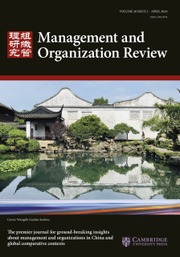No CrossRef data available.
Article contents
Chinese Management Research at a Crossroads: The Past, Present, and Future
Published online by Cambridge University Press: 20 March 2025
Abstract
Contemporary business and management research in China has advanced rapidly, making significant strides in the introduction of theoretical frameworks, research methodologies, local theory development, and practical applications. Much of this research continues to draw on Western theories, and since the reform and opening up, Chinese management research has evolved through distinct stages of globalization and localization. Today, it faces new challenges amid anti-globalization trends. At this critical juncture, the key question is whether China should continue integrating Western theories or capitalize on the opportunity to develop indigenous management theories. This paper explores the differences in scientific development concepts and focuses between China and the West, the historical trajectory of Chinese management research, and the challenges and opportunities that lie ahead. To enhance China's contribution to global management research, we propose that it is essential to sustain international collaboration, deepen understanding of frontline enterprise practices, promote micro-level research and interpretation with Chinese characteristics, and cultivate an open academic community, while optimizing the research evaluation system.
摘要
自改革开放以来,中国管理研究经历了全球化和本地化的不同阶段,而今天又在逆全球化趋势中面临着新的挑战。在这个关键时刻,中国是应该继续整合西方理论,还是利用这个机会发展本土管理理论是十分重要的议题。本文探讨了中西方科学发展观念的差异、中国管理学研究的历史发展轨迹以及面临的挑战和机遇。为了增加中国对全球管理学领域知识的贡献,我们建议必须保持国际开放合作,加深对企业一线实践的 理解,推动具有中国特色的微观层面的研究和解释,并在优化科研评价体系的同时努力培育形成开放的学术社区。
- Type
- Commentary
- Information
- Copyright
- Copyright © The Author(s), 2025. Published by Cambridge University Press on behalf of International Association for Chinese Management Research


